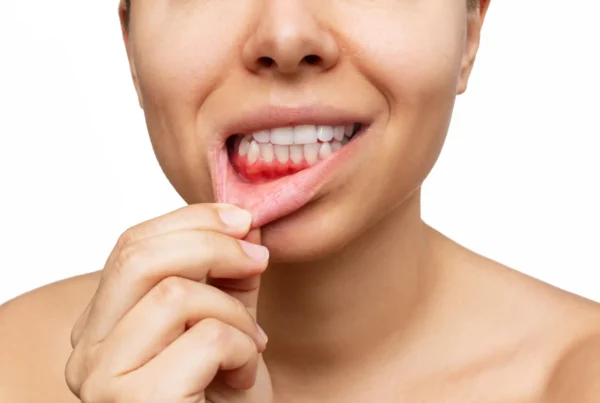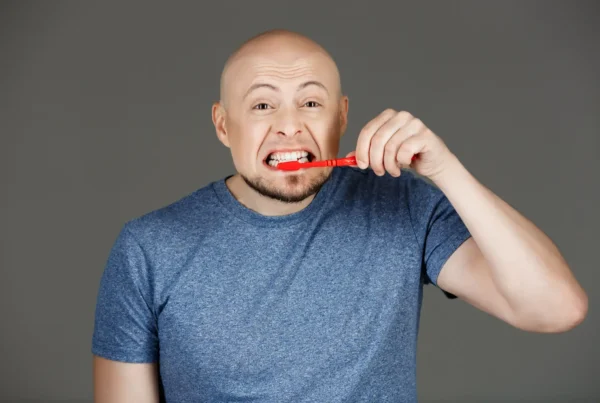Taking care of your oral hygiene is not just about brushing your teeth. If you really care about healthy gums and fresh breath, cleaning between your teeth is also crucial. Dental floss is the most popular choice in such situations, although in recent years there has been increasing talk of an alternative – a dental irrigator, or water flosser.
So which works better? Can an irrigator really replace flossing? Or should these two methods go hand in hand? In this article, we dispel any doubts – based on both expert opinion and the practical advantages of both methods.
Why are interdental spaces so important?
 Let’s start with the basics. Even the most thorough brushing cannot clean the entire surface of the teeth. Interdental spaces are particularly problematic – narrow gaps where food debris, bacteria, and plaque accumulate. These are the most common sources of gum inflammation, tooth decay, and bad breath.
Let’s start with the basics. Even the most thorough brushing cannot clean the entire surface of the teeth. Interdental spaces are particularly problematic – narrow gaps where food debris, bacteria, and plaque accumulate. These are the most common sources of gum inflammation, tooth decay, and bad breath.
That is why experts – both dentists and hygienists – unanimously recommend cleaning these areas every day. For years, the choice was simple: dental floss. Today, however, we have more options.
Dental floss – a classic that works
Dental floss is a thin strip (sometimes coated with wax or fluoride) that we slide between our teeth to mechanically remove plaque and food debris. Its greatest advantage is its precision – when used correctly, it can effectively clean even very tight spaces.
Advantages of dental floss:
- it is cheap, widely available and handy,
- it effectively removes plaque from the surface of the teeth,
- it does not require charging or space in the bathroom.
Disadvantages of dental floss:
- requires skill – improper use can irritate the gums,
- can be difficult to use with braces, implants, or crowded teeth,
- is often overlooked in daily routines because its use is quite time-consuming and inconvenient.
Dental irrigator – a modern alternative
An irrigator is a device that uses a thin, pulsating stream of water to flush food debris and bacteria from between the teeth and below the gum line. It is this pulsation (and not just the pressure) that makes the irrigator so effective.
These devices have gained popularity primarily among people who wear braces and have implants, although more and more people are also using them in their daily hygiene routine.
What are the benefits of an irrigator?
When it comes to usage time, an irrigator usually allows for faster cleaning of the entire mouth. Flossing, especially thorough flossing, is more time-consuming.
In terms of cost, floss obviously has the advantage – it is cheap and available practically everywhere. An irrigator is a bigger expense at the outset, but it is worth treating it as an investment. After purchase, you only use water (and occasionally replace the tips) and electricity, so the operating cost is quite low.
For special needs – such as braces, implants, or bridges – floss often fails. It is difficult to use it to clean the spaces under a bridge or around braces. Here, the irrigator is unmatched.
When traveling, floss obviously wins in terms of size – it fits in your pocket. However, modern cordless irrigators, such as Smilesonic AquaFlow, are compact and lightweight enough to easily fit in your carry-on luggage.
In summary, dental floss is an effective and proven tool, but it requires more effort and does not always work in more demanding cases. An irrigator, on the other hand, offers greater convenience, effectiveness in hard-to-reach areas, and is often easier to use on a daily basis.
Does an irrigator replace flossing?
It depends. In many cases, yes, an irrigator can effectively replace traditional dental floss, especially if:
- you have braces, bridges, or implants,
- you have trouble flossing manually,
- your gums bleed when you use floss,
- you dislike traditional floss and often skip flossing.
An irrigator flushes out more bacteria and debris from under the gum line than floss, as proven by research. At the same time, it is more comfortable and easier to use regularly. However, the best results are achieved by combining both methods – floss for mechanical removal of plaque from the teeth, and an irrigator for deep rinsing and gum massage.
Which irrigator should you choose?
Among the irrigators recommended for daily use (also as a replacement for dental floss), the Smilesonic AquaFlow model is worth mentioning. It is lightweight, cordless, has 5 operating modes, a wide range of pressure settings to choose from, and a set of tips adapted for bridges, braces, and gum pockets, among other things. It is a good choice for people who want to introduce irrigation into their daily routine, regardless of whether they have used dental floss before or not.
Summary – what to choose?
There is no black-and-white answer. Both dental floss and irrigators have their place in oral care. The choice depends on your needs, anatomical conditions, and lifestyle.
In short:
- Do you have braces, implants, bridges, or hard-to-reach areas? → An irrigator will be better.
- Do you have healthy teeth and know how to floss properly? → Floss may be enough.
- Do you want maximum results? → Use both methods alternately or in parallel.
The most important thing is not to limit yourself to brushing your teeth alone. This is not enough in the context of comprehensive oral care – especially in the long term.




